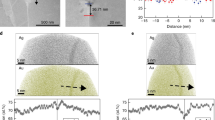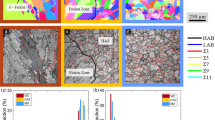Abstract
Face centered cubic metals and alloys have multiple slip systems and are characterized by high dislocation velocities. Nevertheless, these materials suffer from transgranular stress corrosion cracking (T-SCC), that occurs by environmentally-induced cleavage. Since plasticity precedes fracture in all T-SCC phenomena, the evolution of deformation patterning during T-SCC is an important element of the local microfracture mode. Experimental observations show that the presence of the SCC-causing environment during straining is promoting localized plastic deformation at the near-surface region and producing an entirely different deformation pattern compared with that developing in laboratory air. The deformation evolving in the presence of the SCC electrolyte is highly localized, exhibiting closely spaced, coarse slip bands. The amount of localized strain developing at the near-surface region prior to nucleation of stress corrosion cracks is equivalent to the strain required for ductile fracture of the material in air, suggesting the existence of a fundamental fracture criterion. The above phenomenology of the deformation evolution is considered in relation to T-SCC initiation and propagation. The T-SCC is suggested to be a macroscopically brittle but microscopically ductile fracture occurring by localized plastic flow. An environment-induced deformation localization mechanism is described where the role of the environment involves generation of vacancies and subsequent dislocation nucleation from the near-surface region at loads well below those required for normal yielding. The evolution of the localized deformation pattern during T-SCC is suggested to be an outcome of nonuniformity and periodicity in the dissolution process.
Similar content being viewed by others
References
Fundamental Aspects of Stress Corrosion Cracking, S.M. Bruemmer and E.I. Meletis (eds.) TMS-AIME, Warrendale, PA (1992).
Corrosion-Deformation Interactions, T. Magnin and J.M. Gras (eds.), Les Editions de Physique, Les Ulis, France (1993).
E.N.Pugh, Corrosion 41 (1985) 517–526.
E.I.Meletis and R.F.Hochman, Corrosion Science 26 (1985) 63–90.
E.I.Meletis and R.F.Hochman, Corrosion Science 24 (1984) 843–862.
J.A.Beavers and E.N.Pugh, Metallurgical Transactions 11A (1980) 809–820.
K.Sieradzki and R.C.Newman, Philosophical Magazine A 51 (1985) 95–132.
B.D.Lichter, W.F.Flanagan, J.B.Lee and M.Zhu, in Environment-Induced Cracking of Metals, R.P.Gangloff and M.B.Ives (eds.), NACE, Houston, TX (1990) 251–259.
S.Jani, M.Marek, R.F.Hochman and E.I.Meletis, Metallurgical Transactions 22A (1991) 1453–1461.
E.I.Meletis, K.Lian and W.Huang, in Corrosion-Deformation Interactions, T.Magnin and J.M.Gras (eds.) Les Editions de Physique, Les Ulis, France (1993) 69–81.
E.I.Meletis and K.Lian, Journal of the Mechanical Behavior of Metals 6 (1995) 69–84.
K. Lian, ‘A Study of the Stress Corrosion Crack Initiation Stage in α-Brass’, Ph.D. Dissertation, Louisiana State University, August, 1995.
K. Lian and E.I. Meletis, Corrosion, submitted.
J.D.Eshelby, F.C.Frank and F.R.N.Nabarro, Philosophical Magazine 42 (1951) 351–364.
J.Yu, R.N.Parkins, Y.Xu, G.Thompson and G.C.Wood, Corrosion Science 27, No. 2 (1987) 141–157.
I.R.Kramer, B.Wu and C.R.Feng, Materials Science and Engineering 82 (1986) 141–150.
C.F.Lo, W.E.Mayo and S.Weissmann, Corrosion/88, paper No. 282, NACE International, Houston, TX (1988).
K.Kamachi, T.Otsu and S.Abayashi, Transactions of the Japan Institute of Metals 35 (1971) 64–70.
D.B.Kasul, C.L.White and L.A.Heldt, in Environment-Induced Cracking of Metals, R.P.Gangloff and M.B.Ives (eds.) NACE, Houston, TX (1990) 219–222.
I.R.Kramer, C.R.Feng and B.Wu, Materials Science and Engineering 80 (1986) 37–48.
R.N.Pangborn, S.Weissmann and I.R.Kramer, Metallurgical Transactions 12A (1981) 109–120.
T.Magnin, in Strength of Materials, Y.Oikawa et al. (ed.) The Japan Institute of Metals, Tokyo (1994) 25–32.
W.F. Flanagan and B.D. Lichter, Corrosion, submitted.
C.D.Beachem, Metallurgical Transactions 3 (1972) 437–451.
H.K.Birnbaum, in Environment-Sensitive Fracture of Engineering Materials, Z.A.Foroulis (ed.), TMS-AIME, Warrendale, PA (1979) 326–360.
E.I.Meletis and W.Huang, Materials Science and Engineering A 148 (1991) 197–209.
C.Wagner, Journal of the Electrochemical Society 101 (1954) 225–228.
W.W.Mullins, and R.F.Sekerka, Journal of Applied Physics 35 (1963) 323.
T.A.Witten and L.M.Sander, Physics Review Letters 47 (1981) 1400.
P.Meakin, Physics Review A 27 (1983) 604.
R.M.Brady and R.C.Ball, Nature (London) 309 (1984) 225.
P.G.Santarini, Journal de chimie physique 82 (1985) 49–58.
P.G.Santarini, Journal de chimie physique 82 (1985) 329–341.
N.W.Polan, J.M.Popplewell and M.J.Pryor, Journal of the Electrochemical Society 126 (1979) 1299–1300.
J.E.Holiday and H.W.Pickering, Journal of the Electrochemical Society 120 (1973) 470–475.
D.A.Jones and A.F.Jankowski, Scripta Metallurgica et Materiallia 29 (1993) 701–706.
T.R.Pinchback, S.P.Clough and L.C.Heldt, Metallurgical Transactions A 7A (1976) 1241–1243.
H.W.Pickering and C.Wagner, Journal of the Electrochemical Society 114 (1967) 698–706.
R.W.Ballufi and A.V.Granato, Dislocations in Solids, North-Holland: Amsterdam, Holland (1979).
H.G.Vanbueren, Imperfections in Crystals, North-Holland: Amsterdam (1979).
A.N.Stroh, Proceedings of the Royal Society 223 (1954) 404–414.
Author information
Authors and Affiliations
Rights and permissions
About this article
Cite this article
Meletis, E.I., Lian, K. Deformation evolution during initiation of transgranular stress corrosion cracking. Int J Fract 79, 165–178 (1996). https://doi.org/10.1007/BF00032933
Received:
Accepted:
Issue Date:
DOI: https://doi.org/10.1007/BF00032933




